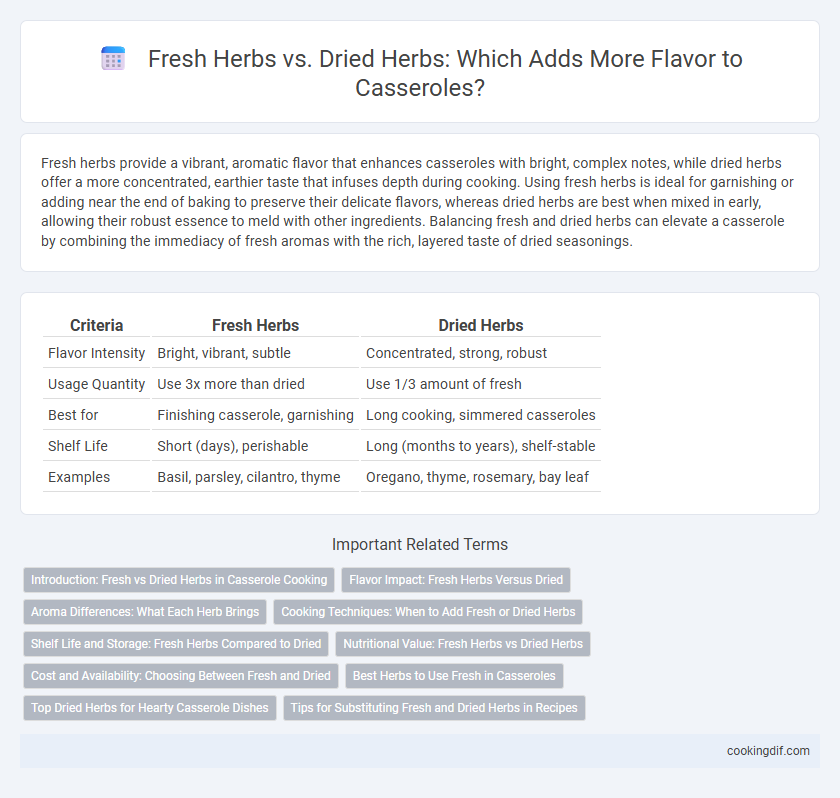Fresh herbs provide a vibrant, aromatic flavor that enhances casseroles with bright, complex notes, while dried herbs offer a more concentrated, earthier taste that infuses depth during cooking. Using fresh herbs is ideal for garnishing or adding near the end of baking to preserve their delicate flavors, whereas dried herbs are best when mixed in early, allowing their robust essence to meld with other ingredients. Balancing fresh and dried herbs can elevate a casserole by combining the immediacy of fresh aromas with the rich, layered taste of dried seasonings.
Table of Comparison
| Criteria | Fresh Herbs | Dried Herbs |
|---|---|---|
| Flavor Intensity | Bright, vibrant, subtle | Concentrated, strong, robust |
| Usage Quantity | Use 3x more than dried | Use 1/3 amount of fresh |
| Best for | Finishing casserole, garnishing | Long cooking, simmered casseroles |
| Shelf Life | Short (days), perishable | Long (months to years), shelf-stable |
| Examples | Basil, parsley, cilantro, thyme | Oregano, thyme, rosemary, bay leaf |
Introduction: Fresh vs Dried Herbs in Casserole Cooking
Fresh herbs in casseroles provide vibrant, aromatic flavors that brighten dishes and infuse natural oils during cooking, while dried herbs offer concentrated, robust essence that intensifies over prolonged baking. The choice between fresh and dried herbs impacts flavor release, with fresh herbs best added near the end of cooking for maximum aroma, and dried herbs preferred at the start to allow slow rehydration and flavor development. Balancing herb type and timing enhances casserole complexity, leveraging basil, thyme, or rosemary fresh or dried depending on desired intensity and cooking duration.
Flavor Impact: Fresh Herbs Versus Dried
Fresh herbs release vibrant, aromatic oils that enhance casseroles with bright, lively flavors, while dried herbs offer a more concentrated, intense taste due to moisture removal. The flavor impact of fresh herbs is generally lighter and more subtle, ideal for finishing dishes, whereas dried herbs infuse deeper, more robust notes during the cooking process. Balancing fresh and dried herbs allows casseroles to achieve a complex and well-rounded flavor profile.
Aroma Differences: What Each Herb Brings
Fresh herbs in casseroles deliver vibrant, aromatic oils that infuse dishes with bright, lively notes, enhancing freshness and complexity. Dried herbs offer a more concentrated, earthy aroma that mellows during slow cooking, contributing depth and a richer, more subtle herbal flavor. Combining both can balance intensity and nuanced fragrance, elevating the casserole's overall sensory profile.
Cooking Techniques: When to Add Fresh or Dried Herbs
Dried herbs release their robust flavors slowly, making them ideal for adding early in the cooking process of casseroles to infuse depth and complexity. Fresh herbs provide bright, vibrant notes best introduced towards the end of cooking or as a garnish to preserve their aromatic oils and delicate texture. Balancing the timing of fresh versus dried herbs ensures optimal flavor development and enhances the overall taste profile of your casserole dish.
Shelf Life and Storage: Fresh Herbs Compared to Dried
Fresh herbs offer vibrant flavors but have a short shelf life, typically lasting only a few days when stored in the refrigerator wrapped in a damp paper towel. Dried herbs provide concentrated flavor and can be stored for up to two to three years in airtight containers, maintaining potency when kept in a cool, dark place. Choosing between fresh and dried herbs depends on the desired intensity of flavor and storage convenience in casserole recipes.
Nutritional Value: Fresh Herbs vs Dried Herbs
Fresh herbs retain higher levels of vitamins and antioxidants compared to dried herbs, providing enhanced nutritional benefits in casseroles. The drying process can reduce certain nutrients, such as vitamin C and essential oils, which contribute to both flavor and health value. Incorporating fresh herbs boosts the casserole's nutrient density while offering vibrant, aromatic flavors.
Cost and Availability: Choosing Between Fresh and Dried
Fresh herbs often come at a higher cost and may be seasonal or limited in availability, especially outside of growing regions, making them less accessible for everyday casserole flavoring. Dried herbs offer a more affordable and readily available option year-round, with concentrated flavors that enhance casseroles without the need for frequent replacement. Balancing cost and accessibility, cooks often select dried herbs for convenience while reserving fresh herbs for dishes where vibrant, nuanced flavors are essential.
Best Herbs to Use Fresh in Casseroles
Fresh herbs like parsley, basil, cilantro, and dill provide vibrant, aromatic flavors that elevate casseroles with their bright and lively taste profiles. These herbs maintain their delicate textures and essential oils when added near the end of cooking or as a garnish, preserving their fresh herbal notes. In contrast, dried herbs such as thyme, rosemary, and oregano offer deeper, more concentrated flavors suited for slow-cooked casseroles, but fresh herbs deliver superior freshness and lightness essential for enhancing layered casserole dishes.
Top Dried Herbs for Hearty Casserole Dishes
Dried herbs such as thyme, rosemary, and oregano provide concentrated flavors that intensify during the slow cooking process of hearty casseroles. These herbs release their essential oils gradually, enriching the dish with robust, earthy notes ideal for meat and vegetable blends. Their long shelf life and potency make them a convenient choice to elevate the savory depth of classic casserole recipes.
Tips for Substituting Fresh and Dried Herbs in Recipes
Fresh herbs offer vibrant flavor and aroma, ideal for garnishing or adding at the end of cooking to preserve their essence, while dried herbs provide concentrated taste that requires earlier incorporation to release their full potential. When substituting, use one-third the amount of dried herbs for fresh due to their potency difference, ensuring balanced seasoning in casseroles. Store dried herbs in a cool, dark place to maintain effectiveness, and chop fresh herbs finely to maximize flavor distribution.
Fresh herbs vs dried herbs for flavoring Infographic

 cookingdif.com
cookingdif.com